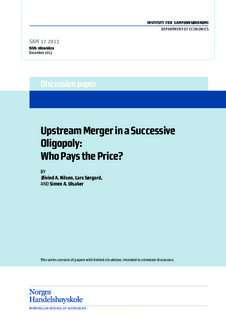Upstream merger in a successive oligopoly : who pays the price?
Working paper

View/
Date
2013-12Metadata
Show full item recordCollections
- Discussion papers (SAM) [657]
Abstract
This study develops and uses a successive oligopoly model, with
an unobservable non-linear tariff between upstream and downstream
firms, to analyze the possible anti-competitive effects of an upstream
merger. We find that an upstream merger may lead to higher average
prices paid by downstream firms, but that there is no change in the
prices paid by consumers. The model is tested empirically on data
for an upstream merger in the Norwegian food sector (specifically, the
market for eggs). Consistent with the theoretical predictions of the
model, we find that the merger had no effect on consumer prices, but
led to higher average prices from the downstream to the upstream firm.